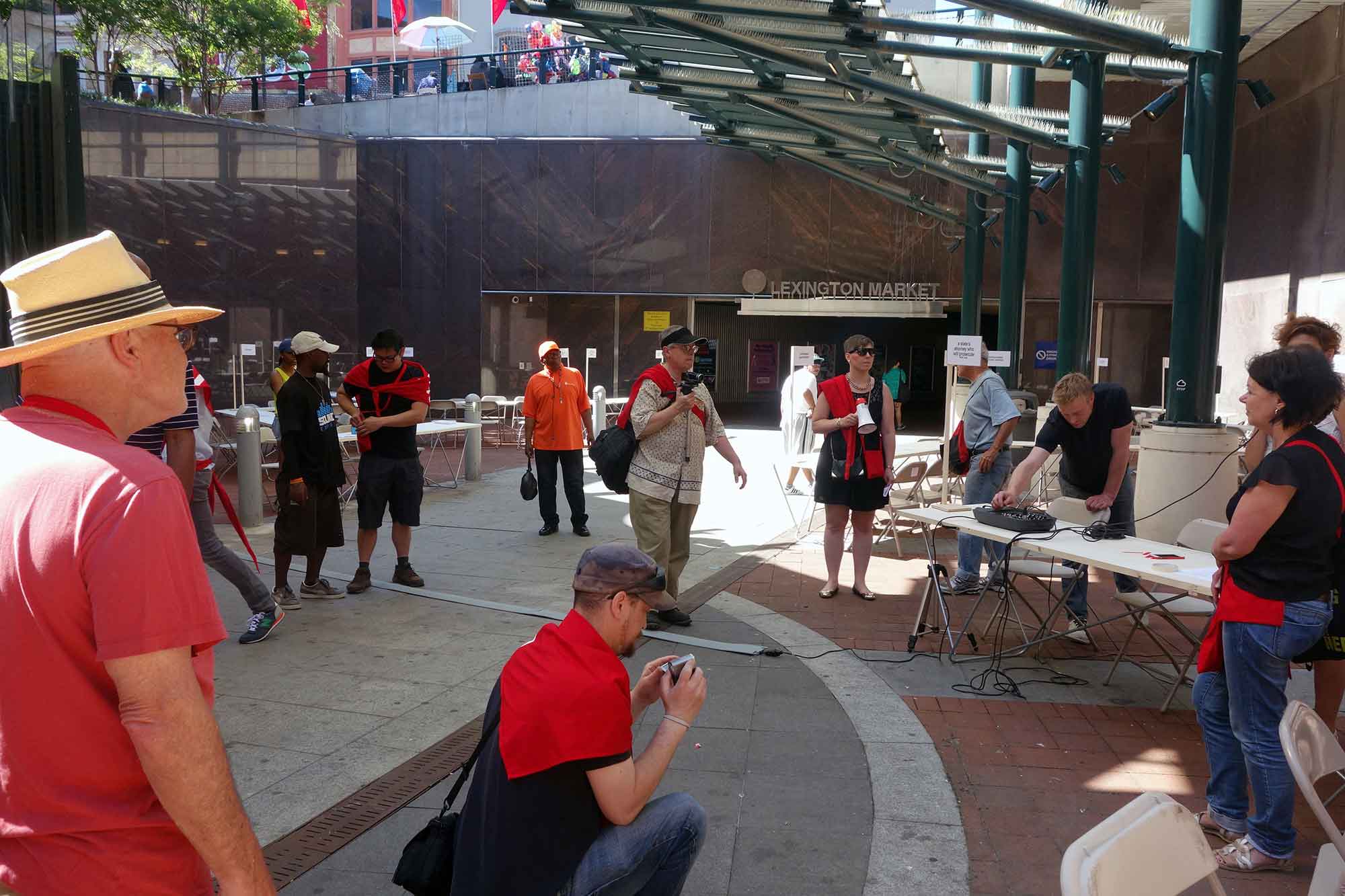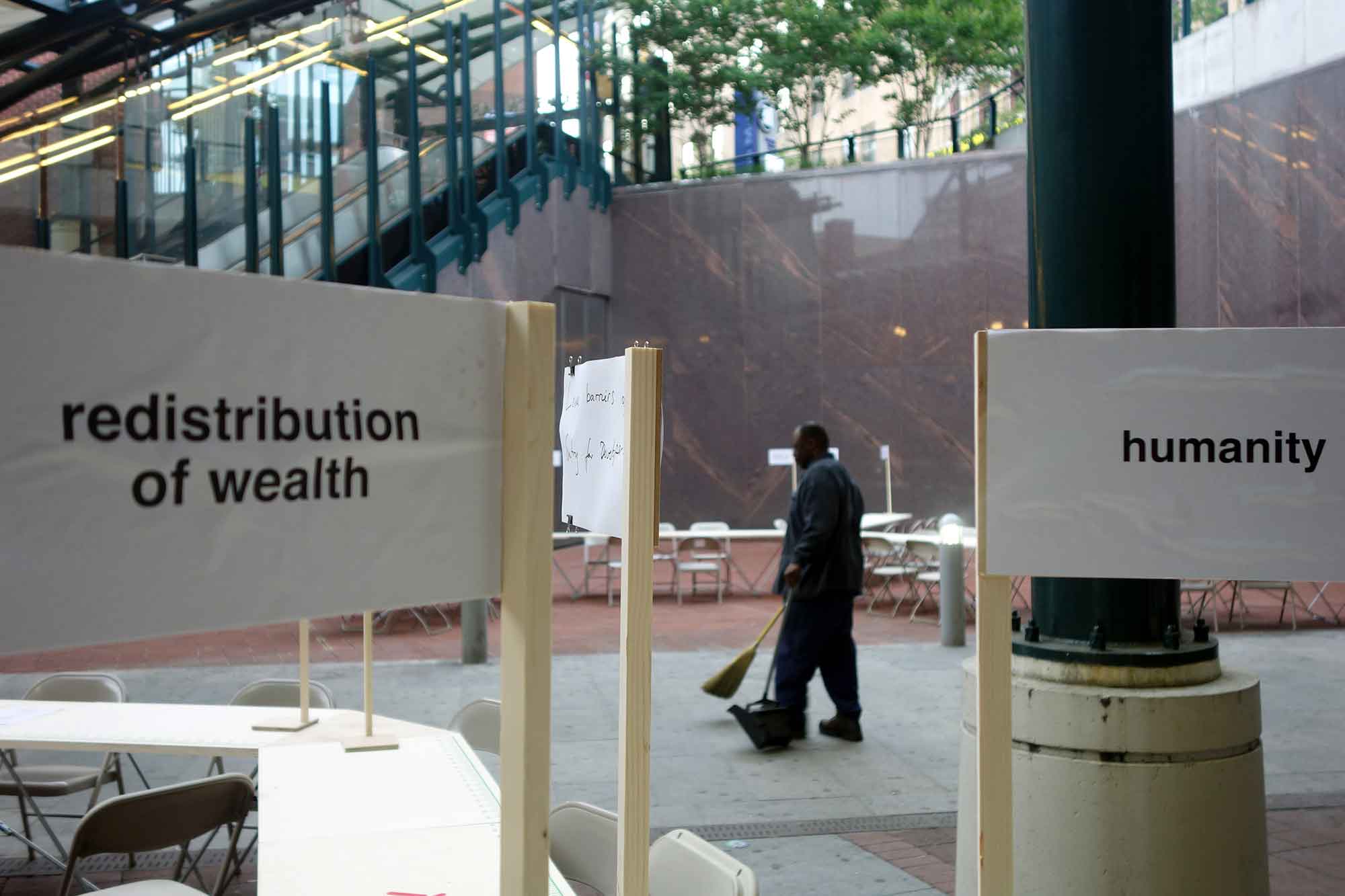- Login
Critical Spatial Practice







The 1st World Congress of the Missing Things was realized in public space in the delapidated former city center of Baltimore, and shifted the usual format of a congress with its division between a panel and an audience – from exclusion to inclusion: its content was produced by the people of Baltimore.
Students of the University of Applied Arts Vienna — The project was part of TRANSIT, an initiative of the Washington, DC cluster of the European Union National Institutes for Culture and the Baltimore Office of Promotions & the Arts, and supported by a grant from the European Union. The project was also supported by a grant from ArtPlace America. Additional support for the Congress was provided by the Maryland Transit Administration.
“Missing Things” are neither a scientific category, nor a usual congress topic. They are up to personal interpretation, sometimes invisible, sometimes visible – especially in contested areas like Lexington Market in Baltimore.
The First World Congress of the Missing Things was conceived and realized at the entrance to the subway station Lexington Market, next to “World Famous Lexington Market” – a historical landmark, which has become a poor signifier of the lack of a social welfare state in the former lively city center. How to return the public voice to the people inhabiting this rundown area of a shrinking city (many of them being homeless, ex-convicts or drug addicts), which had recently been loaded with expectations for raising its property value? For counteracting “Creative Placemaking” which often results in gentrification or employs art as problemsolver, I used the notion of a “congress” for shifting its usual format of an exclusive event to an open access congress in public space.
A rhizomatic setting of tables enabled non-hierarchical dialogs and turned the site into a space of appropriation. The content was collected by people from many different backgrounds and areas in Baltimore as well as by the experts on site: people inhabiting this urban space, who are usually reduced to being considered a “problem” by public authorities, whose voices remain unheard.
At the closing ceremony the “Charter of the Missing Things” was handed over to mayor Stephanie Rawlings-Blake, together with two proposals for next steps: to install a kiosk at the subway entrance providing information on subsidy programs for the local people; to rehab one of the deserted buildings on Howard Street and turn it into a vocational training center for enabling (homeless) people to renovate empty buildings for their own use.
The First World Congress of the Missing Things was then presented at the 65th UN NGO/DPI conference in New York (August 2014), where a funder expressed his interest in financing the next steps, but the City of Baltimore did not show any interest.
Barbara Holub is an artist, architect, researcher, based in Vienna. In 1999 she founded transparadiso with Paul Rajakovics as a transdisciplinary practice in between art, urbanism, architecture and theory. transparadiso has coined the term “direct urbanism”, involving artistic practices for a socially engaged and process based urban development.
In her artistic practice Holub develops performative settings and explores new formats for collaborative processes engaged in urban and societal issues.
Holub was visiting artist and visiting professor at the University of Applied Arts Vienna (2014-2016). She lectures at the Vienna University of Technology, where she directed the research project “Planning Unplanned – May Art Have a Function? Towards a New Function of Art in Society” (2010-2013).
Selected Awards:
Austrian National Art Award (2018); Schindler Grant, MAK Center for Art and Architecture, Los Angeles (2004); Otto-Wagner-Award for Urban Planning (2007).
Barbara Holub was president of the Secession, Vienna (2006–2007); is a member of: advisory board of Art & the Public Sphere Journal; World Council of Peoples for the UN, New York; Expert Committee of the 5th Ural Industrial Biennial/ Ekaterinburg (RUS); Jury “Culture in Public Space”, Stuttgart (D).
Recent publications:
Barbara Holub (ed.) Das Bienvenue: Ein Recht auf Raum für alle (2016).
Barbara Holub/ Christine Hohenbüchler (eds.) Planning Unplanned. Can Art Have a Function? Towards a New Function of Art in Society, Verlag für moderne Kunst (2015).
transparadiso (Barbara Holub/ Paul Rajakovics) Direct Urbanism, Verlag für moderne Kunst (2013).
Current and recent projects/ shows include:
Festival of Regions (A, 2019); The Island is What the Sea Surrounds, European Capital of Culture/ Valletta18 (Malta, 2018); “Request for the unrequested voluntary interlinguisticality”, Pottenhofen (A, 2016); Vienna Biennial (A, 2015); Operation Goldhaube, Salzburg Museum (A, 2015), Mujeres alcanzando la luz, Casa Museo del Banco Nacional (Panama, 2015), The First World Congress of the Missing Things (Baltimore / USA, 2014), Du Bakchich pour Lampedusa (Sousse / TN, 2014), Part of the Game, nGbK (Berlin / D, 2014).
Critical spatial practice is a major reference point for my work (and especially for transparadiso’s method of direct urbanism). My work as an artist oscillates between public space and art institutions, engaging in how to address diverse publics (also in corporate companies) by fostering ‘situations’ for engagement – for returning responsibility to the ‘consumer’ (Michel de Certeau), and how to translate the experience of projects in the urban/public realm into the exhibition space.
This is what I call ‘silent activism’: I want to encourage the audience/ participants to explore their personal potential of engaging in societal issues – investigating the role of art in society as an ongoing parallel level.
Grant Kester, The One and the Many: Contemporary Collaborative Art in a Global Context, (Duke University Press, 2011).
Suzanne Lacy: www.suzannelacy.com
Tania Bruguera: https://www.taniabruguera.com/cms/



































































